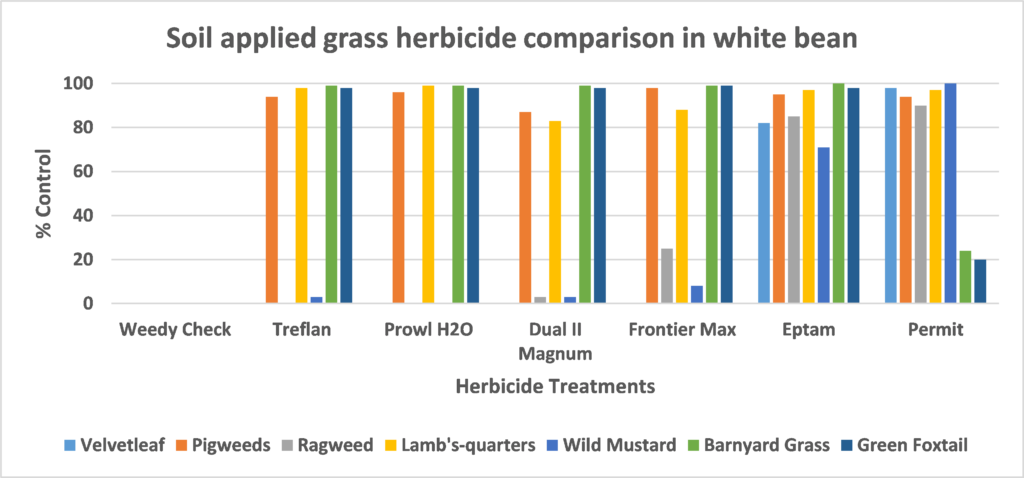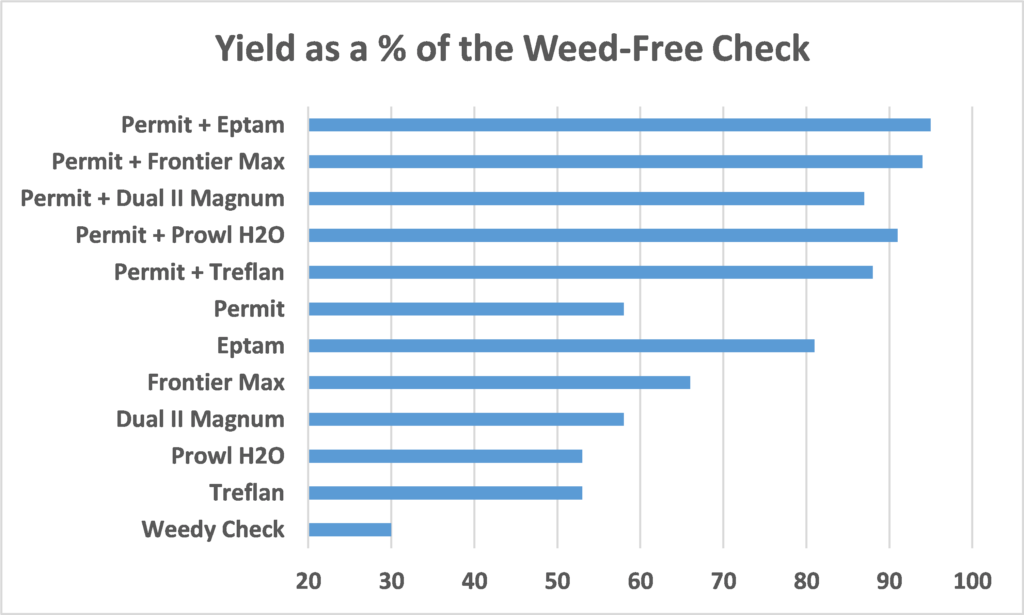Weed control in dry beans can be a daunting task. Management decisions should be based on knowledge of weed pressure and weed species on a field specific basis. There is no one size fits all scenario with weed control in dry beans. The size of farm operations means there is a diverse mix of past crop/weed management practices, a broad range of environments and soil types. This can lead to differing weed species and populations to be aware of when preparing weed control strategies. An understanding of this information will help growers select the correct herbicide program for each individual field. A soil applied herbicide program is a great foundation for managing weeds in dry beans. The aim of this article is to assist you in selecting the right program for each field on your farm.
Background
Pursuit and Permit are the only soil applied broadleaf herbicide options available to Ontario dry bean growers. Treflan, Prowl H2O, Dual II Magnum, Frontier Max and Eptam are currently available soil applied grass herbicides for use in dry beans. Each product provides differing levels of broadleaf weed control. Understanding this can make selecting a product to complement your broadleaf herbicide easier.
Evaluations
Four weed control trials were conducted between 2017 and 2019 at the Huron Research Station and Ridgetown Campus to evaluate five soil applied grass herbicides (Treflan, Prowl H2O, Dual II Magnum, Frontier Max and Eptam) alone or in combination with Permit applied preplant incorporated. Evaluations included crop injury, weed control eight weeks after emergence (WAE), weed density and biomass and white bean yield.
Results
Tankmixes of all five grass herbicides in combination with Permit provided good to excellent weed control of all species evaluated. Improvements in control with the tankmixes were not always significantly different but a trend to improved control was noted. This article will discuss the differences between the herbicide alone treatments. This will make identifying a tankmix partner clearer for individual field circumstances.

Velvetleaf
Eptam provided good control (82%) of velvetleaf 8 WAE while the remaining grass herbicides did not provide any control. Permit provided excellent control (98%) of velvetleaf when applied alone.
Pigweeds (green & redroot)
Treflan, Prowl H2O, Frontier Max, Eptam and Permit provided excellent control (94-98%) of pigweed species evaluated 8 WAE. Dual II Magnum provided good control (87%). Control of pigweeds increased to 99 to 100% when Permit was tankmixed with any of the grass herbicide options evaluated.
Common Ragweed
Eptam provided good control (85%), Frontier Max provided poor control (25%) while the remaining grass herbicides provide no control of common ragweed 8 WAE. Permit provided excellent control (90%) of common ragweed. Control of common ragweed was improved when Permit was tankmixed with Treflan (93%), Frontier Max (94%) and Eptam (98%).
Lamb’s-quarters
Treflan, Prowl H2O, Eptam and Permit alone provided excellent control (97-99%) and Dual II Magnum and Frontier Max provided good control (83-88%) of lamb’s-quarters. All tankmix treatments provided 99 to 100% control of lamb’s-quarters.
Wild Mustard
Permit alone provided excellent control (100%) of wild mustard, Eptam provided fair control (71%) while the remaining grass herbicides did not control wild mustard. There was no improvement in wild mustard control with any of the tankmixes.
Barnyard Grass and Green Foxtail
Permit provided poor control (20-24%) of barnyard grass and green foxtail. All of the grass herbicides evaluated provided greater than 98% control of barnyard grass and green foxtail. The tankmixes with Permit provided similar control to the grass herbicides applied alone.
Yield of White Bean
White bean yield reflected the level of weed control provided by each herbicide or herbicide tankmix. Yields were maximized with tankmix combinations of Permit plus either Frontier Max or Eptam.

Conclusions
Eptam followed by Frontier Max provided the highest broadleaf weed control of all the grass herbicides evaluated. Permit provided excellent control of the broadleaf weeds evaluated and poor control of the grass species. Growers can improve their annual broadleaf and grass weed control by strategically selecting the right tankmix partner. Knowledge of the herbicide options available and the weed species composition in each field is very important to maximize weed control and profitability.
This article was written by Todd Cowan and Peter Sikkema.